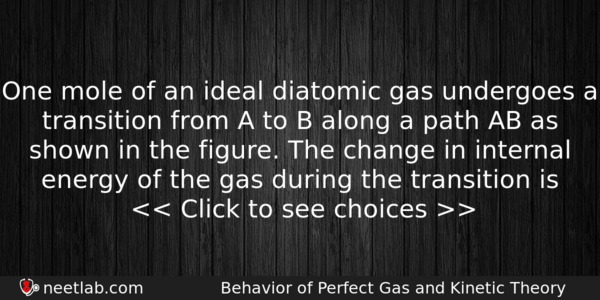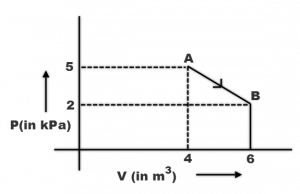| ⇦ | 
| ⇨ |
One mole of an ideal diatomic gas undergoes a transition from A to B along a path AB as shown in the figure.

The change in internal energy of the gas during the transition is
Options
(a) -20 kJ
(b) 20 J
(c) -12 kJ
(d) 20 kJ
Correct Answer:
-20 kJ
Explanation:
No explanation available. Be the first to write the explanation for this question by commenting below.
Related Questions: - The order of radius of the nucleus of an atom is
- A metal bar of length L and area of cross-section A is clamped between two rigid
- Two capacitors of 10pF and 20pF are connected to 200V and 100V sources, respectively.
- The de-Broglie wavelength of an electron moving with a velocity 1.5×10⁸ ms⁻¹ is equal
- Two blocks of masses m₁=4 kg and m₂= 2kg are connected to the ends of a string
Topics: Behavior of Perfect Gas and Kinetic Theory
(34)
Subject: Physics
(2479)
Important MCQs Based on Medical Entrance Examinations To Improve Your NEET Score
- The order of radius of the nucleus of an atom is
- A metal bar of length L and area of cross-section A is clamped between two rigid
- Two capacitors of 10pF and 20pF are connected to 200V and 100V sources, respectively.
- The de-Broglie wavelength of an electron moving with a velocity 1.5×10⁸ ms⁻¹ is equal
- Two blocks of masses m₁=4 kg and m₂= 2kg are connected to the ends of a string
Topics: Behavior of Perfect Gas and Kinetic Theory (34)
Subject: Physics (2479)
Important MCQs Based on Medical Entrance Examinations To Improve Your NEET Score
18000+ students are using NEETLab to improve their score. What about you?
Solve Previous Year MCQs, Mock Tests, Topicwise Practice Tests, Identify Weak Topics, Formula Flash cards and much more is available in NEETLab Android App to improve your NEET score.
Share this page with your friends

ΔU = nCΔT
Also, T = PV/nR
Now,
ΔT = T-T => [PV – PV] / nR
ΔU = nR/¥-1 {PV- PV / nR} [here, ¥ = gamma]
(nR will be cancelled out)
We get,
{-8 x 10^3} / {2/5} = -20kJ.
Hope it helps 🙂